- The design critic Alice Rawsthorn opened this year’s edition, which will continue on December 13 with Yazmany Arboleda, designer of installations for social and political criticism
- The series has featured speakers such as the photojournalist and president of the Magnum Foundation, Susan Meiselas, the award-winning art director Anna Ginsburg, and Gail Bichler, creative director of the New York Times Magazine
The Elisava Faculty of Design and Engineering has launched this October the third edition of the Elisava Masters’ Talks, its cycle of conferences, organized by Elisava's master's and postgraduate degree programmes and featuring internationally recognized speakers. All of them share with the audience their professional experience on topics related to design, communication, architecture, industrial design engineering, art and innovation.
The cycle complements and takes one step further the conferences and talks that Elisava's master's and postgraduate programmes organize periodically to complement students’ training, due to the contributions of numerous prestigious professionals and international figures in design and communication, who share their vision and experiences with the students and the rest of the audience.
All the events in the Elisava Masters’ Talks cycle are free and open to the Elisava community and the general public. In addition, almost all of them can be seen in streaming through Elisava's YouTube channel.
After a first edition held at Elisava in the 2019-2020 academic year, the second edition took place, last academic year, in the Auditorium of the Architects’ Association of Catalonia (COAC), while the edition this year takes a new, significant step forward and moves to the Auditorium of the Disseny Hub Barcelona.

The first speaker this year was Alice Rawsthorn, design critic and author of books such as Design as an Attitude or Design Emergency: Building a Better Future. In her works, Alice talks about design as a potential tool to bring about positive change in the social, political and ecological spheres. In a previous activity organized by Elisava, Design as an Attitude, Rawsthorn reflected on the meaning of design in the future and how it can help address the current challenges posed by the climate emergency, the refugee crisis, or inequality and violence. She also talked about how the new generation of attitudinal designers are reinventing the practice and possibilities of design.
Yazmany Arboleda, designer of immersive installations on social and political issues
The next speaker will be Yazmany Arboleda, the first People’s Artist for New York City at the Civic Engagement Commission and founder of The People's Creative Institute. The artist's work embraces community connections through public, expansive art initiatives, and aims to show the power of art in public spaces. Yazmany is also Senior Artistic Advisor at the Community Art Network and has been commissioned by Carnegie Hall, the Yale School of Management and the United Nations.
Yazmany Arboleda's practice is based on saying that art is not a noun, but a verb. The artist believes that art is a universal language of invention and agency through which culture is defined and redefined, shared experiences are expressed and all possibilities are visualized. His work is inspired by his values, and focuses on collaboration and interdependence as a practice for envisioning the future. The talk, which will take place next on Wednesday 13 December, at Disseny Hub Barcelona, will explore projects by Yazmany Arboleda that show the evolution of his work. More information here.
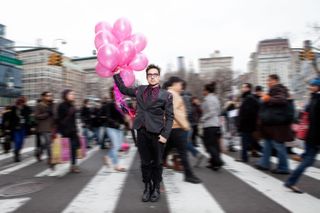
First two editions with increasing reach
Below are short biographies of previous speakers in the cycle. The first edition took place in the 2019-2020 academic year and included the participation of the following professionals:
Renny Ramakers
She is an art historian from Amsterdam, and the co-founder and director of Droog Design, a renowned Dutch experimental design initiative and at the same time a project with a down-to-earth mentality, which opposes the style and high form on which the world of design is based.
In her talk, "Imagination as a Catalyst for Social Change", she proposed a reflection on constant change and how it is necessary to adapt to the great transitions of today’s world, taking into account issues such as digitization, climate change, migration, urbanization and globalization. Ramakers talks about how change can be seen as an opportunity to develop new perspectives and as a source of inspiration to discover a new paradigm in the world of design. It is all about the power of imagination.
Susan Meiselas
A photojournalist known for documenting problems related to human rights in Latin America, her photographs have been recognized with prizes such as the Guggenheim Fellowship (2015) or the Deutsche Börse Photography Foundation Prize (2019). She has also been president of the Magnum Foundation since 2007, mentoring and teaching a new generation of photojournalists.
Her talk "An Ongoing History" proposed a debate on her work on the history of Nicaragua, which is considered a point of reference for war photography due to the controversial and pioneering use of colour. Meiselas has continued to dedicate her work to the fight for human rights around the world.
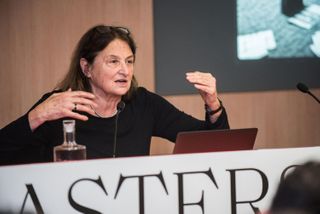
Morag Myerscough
The London-based artist has always lived in the city and has been fascinated by how colour and patterns can change urban environments and people's perception. From schools and hospitals to cultural hubs, Morag transforms public spaces by creating captivating experiences for everyone. Her strong visual focus is instantly recognisable, and her work is bound to create a sense of joy and belonging for all who encounter it.
Typically, she works with community groups to develop ideas that reflect the identity of users, using the heritage and shared cultural history of the local area. Morag is obsessed with the feeling of belonging and talks about it around the world. Her work has been widely published internationally for its social vision, and distinctive use of colour and patterns, which often incorporate positive messages.
The speakers of the cycle come from varied disciplines: from photography to art direction, installations in urban spaces or artificial intelligence
Anna Ginsburg
She is an art director specializing in animation by combining different techniques and methods such as stop-motion, digital images or live-action. Her first music video won the BAFTA New Talent award and since then he has directed films such as Ugly, Private Parts and What is Beauty?
In her talk “Spinning Aubergines, Talking Genitals and the Oldest Women on Earth” Ginsburg talked about her technical and conceptual creative process. In addition, she discussed how her short film Private Parts marked a before and after in her career, how reflection on the ideals of beauty inspired What is Beauty?, and finally how these ideals were projected in her last film, Ugly.
Eva Franch
Architect and art curator, specialized in the production of futures and alternative histories of architecture, she has taught art, architecture and the importance of alternative construction practices around the world. She has also received numerous awards and research grants, and her work has been exhibited internationally.
During her talk "Politics, Economy and Architecture", she explained how architecture has the privilege, but also the responsibility, of articulating what is social, political and economic in a space of redefinition. She also presented a series of provocations, projects and reflections about architecture today, and where this discipline might be tomorrow.
The second edition concluded with a talk by the creative director of the New York Times Magazine
After a pause due to the restrictions imposed by the Covid-19 pandemic, the cycle resumed during the 2022-2023 academic year with the following speakers:
Lev Manovich
He is the most cited author in the world of culture and digital art, and one of the three most cited in media theory and digital humanities. Over three decades, he has published 180 articles and 15 books, and his digital art projects have been in 112 international exhibitions.
In “One billion Rembrandts? Inside Visual AI Revolution” he talked about artificial intelligence (AI) and the revolution it represents in the world of art. Manovich critically evaluated some of the claims that have been made about AI and proposed alternative ways of understanding this new technology. You can see the video presentation here.
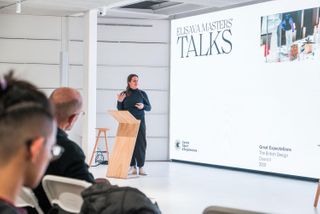
Viviane Stappmanns
Curator of the Vitra Design Museum in Weil am Rhein, she is interested in exploring how the contribution of curators can help to conceive of design as a practice that is concerned with ecology and social sustainability. In her exhibition, she experiments with new, collaborative approaches to the conservation and exhibition of art.
In “Curating for the Common Good”, she discussed the craft of conserving art through the preservation, cultivation and display of valuable objects, and how in the case of design, these objects speak of human drive and progress, creative leadership, and the economy of material and technological innovation. Manovich provided perspectives on how design will be presented, discussed and practiced in the future. You can see the video presentation here.
The programming of the Elisava Masters' Talks cycle represents a further advance in conferences with international speakers organized by Elisava
Jesper Kouthoofd
Head of design, founder and CEO of Teenage Engineering, a Swedish company producing consumer electronics products, his work has been recognized in magazines such as GQ, Vanity Fair and The New York Times. He believes in creating products for everyone, regardless of where they live and what language they speak.
During the talk “Work and life at Teenage Engineering”, Kouthoofd talked about the most relevant projects that have been made at Teenage Engineering, including the famous OP-1 synthesizer and instant cameras.
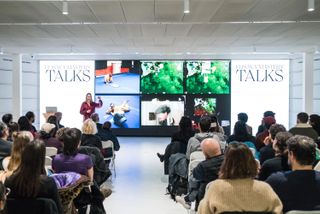
Luna Maurer
She is an an interaction and media design artist, and head of Studio Moniker in Amsterdam, together with Roel Wouters, where they explore the characteristics of technology and its influence on daily life. The studio has won prizes such as the British Music Video award, a Webby and several Dutch Design Awards.
In "Designing Friction" Luna Maurer elaborated on the relationship between her studio and technology over the past twenty years and the impact it has had on her practice. She talked about how the web has gone from being a desktop interface to a fundamental extension of our identity, and shared her most recent experiments. You can see the video presentation here.
Amica Dall
A multidisciplinary professional focused on architecture and city culture, her work as a filmmaker and writer has been published by the BBC and exhibited at the Venice Biennale, among other venues. Currently, she teaches a seminar, entitled Childhood, Culture, Design, at the Architectural Association. She teaches the master’s degree in Situated Practice at the Bartlett School of Architecture, and collaborates with the artist Cristina Lina Fraser on several projects.
In her talk “The Work of Repair”, Amica reflected on how architectural and creative practices can orientate themselves away from invention and innovation towards the patient and slow work of repair, and consider work based on the assumption of long-term personal or ethical commitments with places, situations and social contexts.
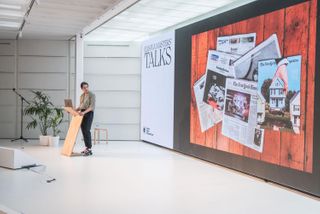
Gail Bichler
She is the creative director of The New York Times Magazine, where she leads the creative team responsible for the design of the magazine and its supplements. She and her team have won numerous awards for their prints and interactive design from organizations such as the Art Directors Club, D&AD or the American Institute for Graphic Arts.
The New York Times Magazine is known for its ambitious journalism, powerful visuals, and bold typefaces. During the "Design for the Times" talk, Bichler talked about how his team approaches the design of the wide range of content that the magazine publishes and the role it plays in the context of the Times. You can see the video presentation here.